Eastern Defense Command
Coast Defense Chesapeake Bay
246th Coast Artillery
T/SGT J. N. England
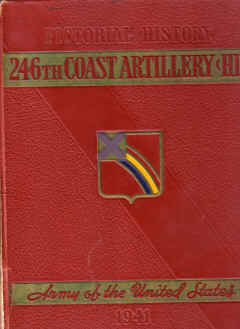
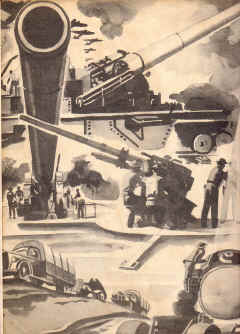
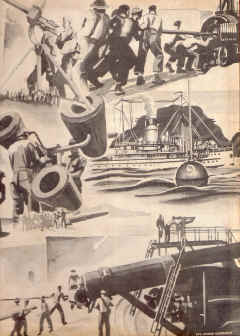
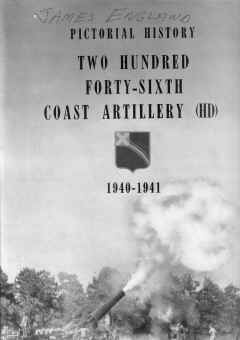
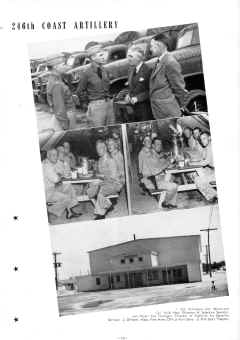
Eastern Defense Command |
Coast Defense Chesapeake Bay |
246th Coast Artillery |
T/SGT J. N. England |
 |
 |
 |
 |
 |
|||
| - | |||
As uncertainty marks the course of world events and Democracy stands on a threshold of unrest and threats of aggressor nations, citizen soldiers of the 246th Coast Artillery again have call calmly adjusted themselves to another unlimited national emergency.
While many of the great nations of the world are in a state of undeclared war and their peoples enslaved to a dictatorial tyranny, guardians of the Mother State-many of them reminiscent of their 1917-18 struggle to save the freedom handed down to them from courageous ancestors-are preparing for any eventuality that may threaten the American way of life. Just as the first European government crumbled under the heel of a monstrous conqueror in this World War II-the Army of the United States signaled for strength. We, of the 246th Coast Artillery (Harbor Defense), are proud to be a part of this vast bulwark between a free, peace-loving nation and a force so destructive that the entire world fears for its safety.
A regiment of the Commonwealth of Virginia-whose military knowledge has been gained over a period of more than three centuries-the 246th Coast Artillery (Harbor Defense), has wholeheartedly answered the call of the President of the United States and is in training at Fort Story and Fort Monroe, on historic Cape Henry and Old Point Comfort, respectively, carefully studying modern coast defense warfare.
This Regiment will be prepared to meet any crisis if and when it is called to defend the nation and Virginia.
Through its Battery B, the 246th Coast Artillery traces its history back to 1856 and its coat of arms reflects the highlights of its past. The shield has artillery red for its background, indicative of its branch of service. The saltire, upper left hand corner, is in honor of the service of one of its units in the Confederate Army in the War Between the States. The rainbow calls attention to the service several of its units saw in the Rainbow (42nd) Division of the First World War.
The Regiment's crest is the seal of the Commonwealth of Virginia, and the regimental motto-Prepared to Defend-is in keeping with its mission. The regimental colors carry two streamers in recognition of combat service in France in two major offensives: St. Mihiel, September 12-16, 1918; Meuse-Argonne, September 26 to November 11, 1918.
The 246th C. A. was originally organized in 1921 by Colonel Marshall M. Milton, its first commanding officer. Formed when Jo Lane Stern was Adjutant General, its letterhead for a time carried the appellation: "The Jo Lane Stern Artillery." Federally recognized December 15, 1921 as the First Provisional Regiment, Coast Artillery Corps, Virginia National Guard, it was composed of the First, Second, Third, Fourth, Fifth, Sixth and Seventh Companies, C. A. C., Virginia National Guard, stationed at Richmond, Lynchburg, Gordonsville, Clifton Forge, Christiansburg, Buchanan and Chmcoteague, respectively. The service section of Headquarters Battery was organized in Richmond and the Band Section of that Battery in Danville.
The line units at Richmond, Lynchburg, Clifton Forge and Roanoke, and the Medical Detachment and Service Section of Headquarters Battery never changed their home stations, but the unit organized at Gordonsville transferred to Danville, that at Christiansburg to Blacksburg,that at Buchanan to Covington, and the Chincoteague company to Christiansburg, then to Vinton. The Band Section has kept its home station at Lynchburg, after transferring from Danville.
The Regiment's first redesignation was on April 1, 1922, when it became the First Coast Defense Command, Virginia National Guard, and its companies were redesignated in numerical sequence from 409th to 416th, inclusive. On November 5, 1923, it became the 246th Artillery (60th Virginia Artillery), Virginia National Guard. The parenthetical part of the designation was in recognition of the descent of some of its units from those of the 60th Regiment, C. A. C., a Virginia organized unit of the First World War, in which Colonel Milton had served as a Major. In this redesignation, the line units were given their current alphabetical designations, Batteries A to F, inclusive.
On August 19, 1924, the organization was designated 246th Coast Artillery (Harbor Defense), its present designation. On March 15, 1926, Colonel Milton was succeeded by Colonel Frank B. Varney, former regimental executive, who in turn was succeeded by Colonel Alonzo E. Wood, who had served successively as First Lieutenant, Captain, Major, and Lieutenant Colonel. In the Spring of 1929 Regimental Headquarters was moved from Richmond to Lynchburg, its location at the time the Regiment was inducted into Federal Service, on September 16, 1940.
Annual regimental two-week field training periods have been held at Fort Monroe, 1922 to 1936, inclusive, and in 1937-39, at Fort Story, where it manned and fired service target practice on 12-inch railway mortars, 8-inch railway guns and 155 mm G. P. F. guns. It served an additional seven-day period of field training at Fort Story in November, 1939. The Medical Detachment, Headquarters Battery (Service Section), and Batteries A, E, F and H, organized as a provisional regiment commanded by Colonel Wood, served on "strike duty" at
Schoolfield, Va., from January 23 to February 9, 1931.
In May, 1940, the 246th C. A. was again reorganized in accordance with War Department plans. The Third Battalion (A.A.) was organized by Lieutenant Colonel Randolph McG. Cabell, its present commanding officer, and consisted of Headquarters Battery and Battery I, both of Roanoke, and Batteries G and H, both of Salem.
The War Department, in July, 1940, ordered that the Regiment remain in training at Fort Story for three weeks, instead of the two-week training periods which the organization had undergone in previous years, and on September 16, the Regiment was among the first contingent of Guard units to be inducted into the Army o. the United States. Regimental Headquarters and Headquarters Battery, and Batteries D, F, and 2nd Battalion Headquarters Battery were ordered to Fort Monroe, while the remaining units came to Fort Story. On December 19, 1940, Regimental Headquarters and Headquarters Battery were transferred to Story, and Battery H was ordered to Fort Monroe, to join the units there.
Members of the 246th arriving at Fort Story after their induction found much work to be done, and in addition, had to remain under canvas until December 1, while barracks and other facilities were under construction. Fatigue details occupied a great deal of the troops' time, but looking back on those days, we realize that more progress was made in training the men than was expected.
The Fort Monroe units were, soon after their arrival on September 23, 1940, busy in fulfilling troop requirements for the Coast Artillery Board, and the Coast Artillery School; these requirements being their primary duties. Tents formed their homes until December 23. at which time they moved into new quarters that had just been completed.
The Regiment was fortunate in having with it until late in the fall of 1940 its unit instructors, Colonel Samuel F. Hawkins and Lieutenant Colonel Herbert H. Blackwell. Both served in advisory capacities, and training of the men settled down in all seriousness by the time they left the Regiment. We also had the services of Technical Sergeant William G. Berry, former sergeant-instructor in the National Guard, who later, on March 31, 1941, retired from active service upon completion of a long number of years in the Army. A Regimental Review was held in his honor a few days before he left for his home in Tennessee.
With headquarters at Fort Monroe, Major General Frederic H. Smith and Brigadier General Rollin T. Tilton have served in their respective order as commanders of the Harbor Defenses of the Chesapeake Bay since the 246th Coast Artillery has become an affiliate. Lieutenant Colonel Dale D. Hinman and Colonel R. B. Cocroft have been the commanding officers at Fort Story.
The 246th Coast Artillery has steadily grown both in strength and efficiency since the early days of its induction into the Federal Service. Training programs have been greatly broadened to take in each phase of Coast Artillery; alertness and the morale and physical fitness are on the upgrade throughout the ranks. On January 14th the first group of selectees--188 young Virginians-arrived at Fort Story and were assigned to the various batteries of this Regiment, with the exception of the Monroe units, which already had been brought up to war strength, due to the transfer of guardsmen from the Story units. In July, 94 Selective Service men arrived from the Coast Artillery Replacement Center, Fort Eustis, and practically all of the men were from New York and New Jersey. All of the earlier arrivals had been Virginians
The enlisted men at Fort Story have found a good deal of pleasure in the recreation facilities afforded them in the spacious new Service Men's Club, now open on the Post, and at the new War Department Theatre, which has adopted a policy of providing the men with first-run pictures. The attractions at the nearby beaches also have helped materially to build a higher morale, of which we are proud. That is not to mention the services rendered the enlisted men by the United Service Organizations, which have provided entertainment and everything possible to help the soldier spend his enlistment in as much happiness as possible.
The first year in the Federal service has just ended for the 246th C. A., and a gala celebration marking the end of 12 months of hard training was held. A spectacular regimental review marked the year's end, on September 16, when the troops were reviewed by Brig. Gen. S. Gardner Waller, Adjutant General, Commonwealth of Virginia; Brig. Gen. Rollin L. Tilton, Commanding General, Harbor Defenses of Chesapeake Bay; Col. R. B. Cocroft, Post Commander, Fort Story; Lieut. Col. Mills F. Neal, Director of Selective Service, Commonwealth of Virginia; and other dignitaries of the military and private life. And at the close of the year, the War Department's policy of releasing a percentage of the men, for various reasons, is taking shape, and it is expected, barring any unseen complications. that approximately 60 per cent of the Regiment will be able to return to their homes by January 1, if they so desire.
This will mean bringing in an additional large number of trainees. It is hoped, by the personnel now here, that our successors will assume the same spirit of responsibility and maintain the high morale that have been shown by the National Guardsmen and Selective Service men during the past 12 months.
Among the 246th Coast Artillery's prized possessions is the sword of its first commanding officer, the late Marshall M. Milton. This sword was presented to the Regiment with appropriate ceremony by the Rev. W. B. Lee Milton, eldest son of the late Colonel Milton.
The Regiment takes this opportunity to pay homage to the following Regular Army instructors who, in addition to Colonels Hawkins and Blackwell and Sergeant Berry, have been detailed to it since its organization: Capt. Phillip B. Taliaferro, Major Glenn P. Anderson, Major James deB. Walbach, Lieut. Col. M. M. Kimmel. Lieut. Col. Jesse L. Sinclair, Jr., Major Robert C. Snidow, Technical Sergeant Benjamin F. Hinson, and Staff Sergeant James H. Tays.